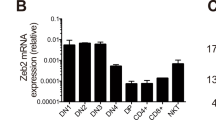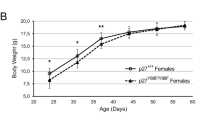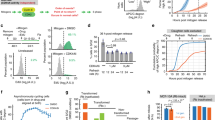Abstract
Previous results suggested a potential role for T-cell protein tyrosine phosphatase (TC-PTP) in cell proliferation. However, no conclusive data has supported such a function in the modulation of this process. In order to clarify this issue, we isolated TC-PTP−/− murine embryonic fibroblasts (MEFs) as well as cell lines to characterize the role of TC-PTP in the control of cell proliferation and cell cycle. Both TC-PTP−/− primary MEFs and cell lines proliferate slower than TC-PTP+/+ cells. We also demonstrated that TC-PTP−/− cells have a slow progression through the G1 phase of the cell cycle. Further characterization of the G1 defect indicates that the kinetics of cyclin D1 induction was delayed and that p27KIP1 remains at higher levels for an extended period of time. Moreover, cells lacking TC-PTP showed a delayed activation of CDK2. This slow progression through the early G1-phase resulted in decreased phosphorylation of the RB protein and subsequent delay into the S phase transition. In contrast, no further defects were detected in other phases of the cell cycle. Survey of the potential signaling pathways leading to this delayed cyclin D1 expression indicated that NF-κB activation was compromised and that IKKβ activity was also reduced following PDGF stimulation. Reintroduction of wild-type TC-PTP into the TC-PTP−/− cells rescued the defective proliferation, cyclin D1 expression, NF-κB activation as well as IκB phosphorylation. Together, these results confirm that TC-PTP plays a positive role in the progression of early G1 phase of the cell cycle through the NF-κB pathway.
This is a preview of subscription content, access via your institution
Access options
Subscribe to this journal
Receive 50 print issues and online access
$259.00 per year
only $5.18 per issue
Buy this article
- Purchase on Springer Link
- Instant access to full article PDF
Prices may be subject to local taxes which are calculated during checkout







Similar content being viewed by others
References
Bargou RC, Emmerich F, Krappmann D, Bommert K, Mapara MY, Arnold W, Roger HD, Grinstein E, Scheidereit C . 1997 J. Clin. Invest. 100: 405–455
Cheng M, Sexl V, Sherr CJ, Roussel MF . 1998 Proc. Natl. Acad. Sci. USA 95: 1091–1096
Cheng M, Olivier P, Diehl JA, Fero M, Roussel MF, Roberts JM, Sherr CJ . 1999 EMBO J. 18: 1571–1583
Cool D, Tonks N, Charbonneau H, Walsh K, Fischer E, Krebs E . 1989 Proc. Natl. Acad. Sci. USA 86: 5257–5261
Diehl JA, Cheng M, Roussel MF, Sherr CJ . 1998 Genes Dev. 12: 3499–3511
Fagan R, Flint K, Jones N . 1994 Cell 78: 799–811
Ferreira V, Sidenius N, Tarantino N, Hubert P, Chatenoud L, Blasi F, Korner M . 1999 J. Immunol. 162: 6442–6450
Gille H, Downward J . 1999 J. Biol. Chem. 274: 22033–22040
Grumont RJ, Rourke IJ, O'Reilly LA, Strasser A, Miyake K, Sha W, Gerondakis S . 1998 J. Exp. Med. 187: 663–674
Guttridge DC, Albanese C, Reuther JY, Pestell RG, Baldwin ASJ . 1999 Mol. Cell Biol. 19: 5785–5799
Habib A, Chatterjee S, Park S, Ratan R, Lefebvre S, Vartanian T . 2001 J. Biol Chem. 276: 8865–8874
Hengst L, Reed SI . 1996 Science 271: 1861–1864
Hinz M, Krappmann D, Eichten A, Heder A, Scheidereit C, Strauss M . 1999 Mol. Cell Biol. 19: 2690–2698
Hsiao K, McMahon S, Farnham P . 1994 Genes Dev. 8: 1526–1537
Ibarra-Sánchez M, Simoncic P, Nestel F, Lapp W, Tremblay ML . 2000 Semm. Immunol. 12: 379–386
Johnson D, Ohtani K, Nevins J . 1994 Genes Dev. 8: 1514–1525
Kerkhoff E, Rapp UR . 1997 Mol. Cell Biol. 17: 2576–2586
Kerkhoff E, Rapp UR . 1998 Oncogene 17: 1457–1462
Liou H-CJZ, Tumang J, Andjelic S, Smith KA . 1999 Int. Immunol. 11: 361–371
Llyod AC, Obermuller F, Staddon SCB, McMahon M, Land H . 1997 Genes Dev. 11: 663–677
Lorenzen J, Dabaday C, Fischer E . 1995 J. Biol Chem. 14: 631–643
Mosinger B, Tillmann U, Westphal H, Tremblay ML . 1992 Proc. Natl. Acad. Sci. USA 89: 499–503
Mosmann T . 1983 J. Immunol. Methods 62: 55–63
Muise-Helmericks RC, Grimes HL, Bellacosa A, Malstrom SE, Tsichlis PN, Rosen N . 1998 J. Biol. Chem. 273: 29864–29872
Nambirajan S, Radha V, Kamatkar S, Swarup G . 2000 J Biosci. 25: 33–40
Nambirajan S, Reddy R, Swarup G . 1995 J Biosci. 20: 461–471
Neuman E, Flemington E, Sellers W, Kaelin WJ . 1994 Mol. Cell Biol. 14: 6607–6615
Nourse J, Firpo E, Flanagan WM, Coats S, Polyak K, Lee MH, Massague J, Crabtree GR, Roberts JM . 1994 Nature 372: 570–573
Pagano M, Tam SW, Theodoras AM, Beer-Romero P, Del Sal G, Chau V, Yew PR, Draetta GF, Rolfe M . 1995 Science 269: 682–685
Radha V, Nambirajan S, Swarup G . 1997 FEBS lett. 409: 33–36
Serrano M, Lin AW, McCurrach ME, Beach D, Lowe SW . 1997 Cell 88: 593–602
Sewing A, Wiseman B, Llyod AC, Land H . 1997 Mol. Cell. Biol. 17: 5588–5597
Sha WC, Liou H-C, Toumanen EI . 1995 Cell 80: 321–330
Sheaff RJ, Groudine M, Gordon M, Roberts JM, Clurman BE . 1997 Genes Dev. 11: 1464–1478
Sherr CJ . 1994 Cell 79: 551–555
Sherr CJ . 1996 Science 274: 1672–1677
Sherr C, Roberts J . 1999 Genes Dev. 13: 1501–1512
Snapper CM, Zelazowski P, Rosas FR, Kehry MR, Tian M, Baltimore D, Sha WC . 1996 J. Immunol. 156: 183–191
Tiganis T, Bennett A, Ravichandran K, Tonks N . 1998 Mol. Cell Biol. 18: 1622–1634
Tiganis T, Flint A, Adam S, Tonks N . 1997 J. Biol. Chem. 272: 21548–21557
Tillmann U, Wagner J, Boerboom D, Westphal H, Tremblay ML . 1994 Mol. Cell Biol. 14: 3030–3040
Tonks N, Neel B . 2001 Curr. Opin. Cell Biol. 13: 182–195
Vidal A, Koff A . 2000 Gene 247: 1–15
Vlach J, Hennecke S, Amati B . 1997 EMBO J. 16: 5334–5344
Woods D, Parry D, Cherwinski H, Bosch E, Lees E, McMahon M . 1997 Mol. Cell Biol. 17: 5598–5611
You M, Flick L, Yu D, Feng G . 2001 J. Exp. Med. 193: 101–110
You-Ten K, Muise E, Itie A, Michaliszyn E, Wagner J, Jothy S, Lapp WS, Tremblay ML . 1997 J. Exp. Med. 186: 683–693
Acknowledgements
We are grateful to Phil E Branton for the generous gift of anti-RB antibody. We thank Alan Cheng, Jean François Côté, Mounib Elchebly, Pankaj Tailor and François Blondeau for helpful discussion and critical reading of the manuscript. We acknowledge the contribution of Eva Michaliszyn, Jacklin Quinlan and Ailsa Lee Loy for their excellent technical work. We also thank Louie Lamorte and Morag Park for their suggestions and help in the generation of the TC-PTP retrovirus expression vector. María de Jesús Ibarra-Sánchez received studentships from the Canderel Foundation, the Alexander McFee Memorial Fellowship and the Internal Studentship of Faculty of Medicine at McGill University. ML Tremblay is a Scientist of Canadian Institutes for Health Research (CIHR). This work was supported by an operating grant to ML Tremblay from the National Cancer Institute (NCI) of Canada.
Author information
Authors and Affiliations
Corresponding author
Rights and permissions
About this article
Cite this article
Ibarra-Sánchez, M., Wagner, J., Ong, MT. et al. Murine embryonic fibroblasts lacking TC-PTP display delayed G1 phase through defective NF-κB activation. Oncogene 20, 4728–4739 (2001). https://doi.org/10.1038/sj.onc.1204648
Received:
Revised:
Accepted:
Published:
Issue Date:
DOI: https://doi.org/10.1038/sj.onc.1204648
Keywords
This article is cited by
-
Doxorubicin induces atypical NF-κB activation through c-Abl kinase activity in breast cancer cells
Journal of Cancer Research and Clinical Oncology (2013)
-
PTP1B and TC-PTP: regulators of transformation and tumorigenesis
Cancer and Metastasis Reviews (2008)
-
Interferons induce tyrosine phosphorylation of the eIF2α kinase PKR through activation of Jak1 and Tyk2
EMBO reports (2007)
-
Selective regulation of tumor necrosis factor–induced Erk signaling by Src family kinases and the T cell protein tyrosine phosphatase
Nature Immunology (2005)
-
Protein tyrosine phosphatase 1B inhibitors for diabetes
Nature Reviews Drug Discovery (2002)



